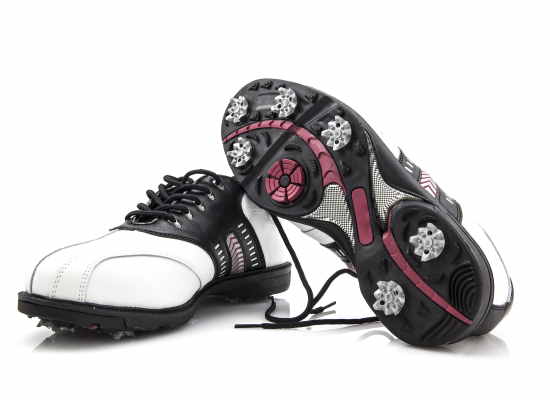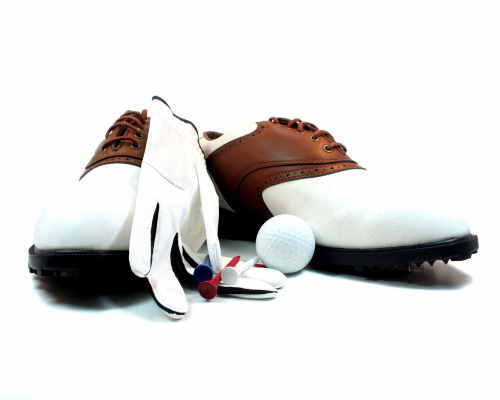Oops, something went wrong. Please try again.
You are now logged in!
Oops, something went wrong. Please try again.
You are now logged in!
 You may not always think about it, but the right golf shoes can impact your
game. The right golfing shoes
can keep you comfortable through all 18 holes. And spiked golf shoes can give a golfer more grip during
a drive on
those wet or hilly courses. Our selection of high-quality name brands can give you the performance edge
you need on the golf course. Brands like Footjoy, Callaway, Adidas, and more can keep you comfortable
even during the most challenging shots.
You may not always think about it, but the right golf shoes can impact your
game. The right golfing shoes
can keep you comfortable through all 18 holes. And spiked golf shoes can give a golfer more grip during
a drive on
those wet or hilly courses. Our selection of high-quality name brands can give you the performance edge
you need on the golf course. Brands like Footjoy, Callaway, Adidas, and more can keep you comfortable
even during the most challenging shots.
Selecting the right golf shoes is essential for optimizing performance on the course. A solid foundation starts with footwear that enhances stability, comfort, and traction.
When choosing golf shoes, consider the following factors:
 No, spikeless shoes use a design offering a fair degree of grip
on the course. The design uses a textured bottom that gives you more grip than a typical athletic shoe.
No, spikeless shoes use a design offering a fair degree of grip
on the course. The design uses a textured bottom that gives you more grip than a typical athletic shoe.
Spiked golf shoes offer superior grip on the course. A reliable grip is essential to a steady, effective swing.
Spikes can be replaced easily as they wear down, ensuring you have superior support and traction when you go to swing.
The traction offered by spiked golf shoes is ideal for wet or muddy conditions where extra grip is necessary on damp, slippery turf.
Both offer traction on the golf course. Spiked shoes might be more suitable in extreme conditions, where the ground is wet or steep. However, today's spikeless golf shoes offer much better traction than in the past, and many newer spikeless golf shoes can provide traction comparable to spiked golf shoes.
Spikeless shoes tend to be lighter and more flexible, which can help prevent fatigue in your legs and feet. And spikeless shoes are often made with a soft spike or cleat for added traction. A great example of a spikeless shoe is the Footjoy Hyperflex Shoe. It offers traction and comfort with the strengths of both a golf shoe and an athletic shoe.
Spiked golf shoes provide superior traction and stability on the course, making them ideal for wet or uneven terrain, while spikeless shoes offer versatility for both on-course and casual wear, delivering comfort and ease of movement without sacrificing grip.
Golfing with soggy feet isn't fun, especially over 18 holes. In many climates, wet ground conditions can be common, and a water-resistant or waterproof shoe can help keep you comfortable and dry. Many shoes like the Etonic Stabi-LIFE Golf Shoes are made with flexible waterproof fabric to help keep your feet dry and keep you performing your best.
You need to combine traction, performance, and warmth for colder weather to support you on those cooler days. Ecco Golf S Three Spikeless Shoes are handcrafted with durable yet soft leather that provides a snug, warm fit, keeping your feet warmer.
If you are in a warmer or more humid climate, shoes designed for breathability and moisture management can be essential. Callaway Golf Del Mar Shoes are made with the Opti Vent Mesh liner helping your feet stay more relaxed.
While some casual players do, golf shoes are designed with features indispensable on the course that a regular athletic shoe might not have. One feature is waterproofing. Many golf shoes are designed to be waterproof or heavily water-resistant. A great example is the FootJoy Golf Superlites XP BOA Spikeless Shoes. This shoe is guaranteed to be waterproof for up to 24 months. Can you imagine the alternative like playing 18 holes with soggy waterlogged shoes?
Believe it or not, there are many things you can do to help maintain your golf shoes. One simple thing is to clear off debris from the exterior of the shoe. When drying, bring them indoors and let them sit at room temperature. Finally, unscrew and clean the spikes and clean out any debris trapped between the spike and the bottom of the shoe.
It’s recommended to replace your golf shoes every 1-2 years, or sooner if you notice significant wear and tear. Signs that it's time for a new pair include loss of traction, visible damage, or discomfort during play.
For any golfer, owning a quality pair of golf shoes is essential. They offer a combination of comfort, style, and stability, and the right pair can substantially increase a player’s experience on the course. Below are three top of the line golf shoes that make excellent gifts for any golf enthusiast:

